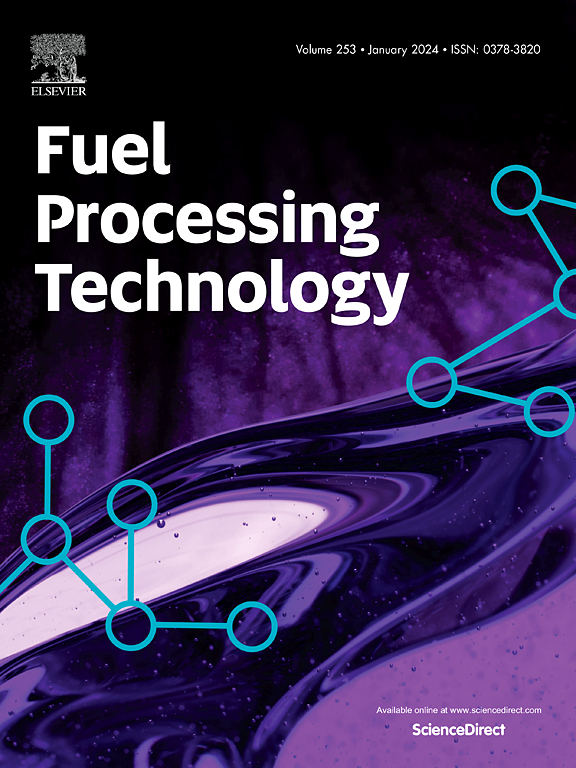四种氧载体在原位氧化还原射流磨损反应器中的磨损行为分析
IF 7.7
2区 工程技术
Q1 CHEMISTRY, APPLIED
引用次数: 0
摘要
氧载体(OCs)的抗磨损性能对化学环工艺的运行成本有重要影响。定制的喷射磨耗反应器通过冷、热和氧化还原磨耗测试来评估四种OC的耐磨耗性:钛铁矿(Ilm-NO)、高压成型CuFe- hy双矿OC (CuFe- hy)和两种喷雾干燥和高压成型钙钛矿(Per-SD和Per-Hy)。所有测试的抗磨损性能顺序为:Ilm-NO >;Per-Hy祝辞CuFe-Hy祝辞Per-SD。进行测试后的表征,包括消耗的颗粒和捕获的粉末的粒度分布,结构性能和成分演变。氧载体寿命是根据颗粒大小分布来量化的。影响氧载体磨损的多重应力表现为拮抗相互作用,而不是线性叠加。观察了氧载体的元素迁移、颗粒膨胀和强度演化。颗粒密度和破碎强度与氧载体的抗磨损性能密切相关。本研究建立了一种高效的高速射流原位氧化还原条件下氧化膜的评价方法,为设计高耐磨耗氧化膜和推进氧化膜的磨损机理研究提供指导。本文章由计算机程序翻译,如有差异,请以英文原文为准。
Attrition behavior analysis of four oxygen carriers in the in-situ redox jet attrition reactor
The anti-attrition properties of oxygen carriers (OCs) significantly impact the operation cost in chemical looping processes. A custom jet attrition reactor evaluates the attrition resistance of four OCs: ilmenite (Ilm-NO), Cu![]() Fe bi-ore OC via hydroforming (CuFe-Hy), and two perovskites via spray drying and hydroforming (Per-SD and Per-Hy), through cold, hot, and redox attrition tests. The anti-attrition performance order across all tests is Ilm-NO > Per-Hy > CuFe-Hy > Per-SD. Post-testing characterizations are conducted, including particle size distributions of consumed particles and captured powders, structure properties, and compositional evolution. Oxygen carrier lifetimes are quantified based on the particle size distributions. Multiple stresses affecting oxygen carrier attrition exhibit antagonistic interactions rather than linear superposition. Element migration, particle expansion, and strength evolution of the tested oxygen carriers are observed. Particle density and crushing strength are highly related to the anti-attrition properties of oxygen carriers. This study develops an efficient method for evaluating OCs under the in-situ redox condition with a high-velocity jet, offering guidance for designing OCs with high attrition resistance and advancing the study of attrition mechanisms.
Fe bi-ore OC via hydroforming (CuFe-Hy), and two perovskites via spray drying and hydroforming (Per-SD and Per-Hy), through cold, hot, and redox attrition tests. The anti-attrition performance order across all tests is Ilm-NO > Per-Hy > CuFe-Hy > Per-SD. Post-testing characterizations are conducted, including particle size distributions of consumed particles and captured powders, structure properties, and compositional evolution. Oxygen carrier lifetimes are quantified based on the particle size distributions. Multiple stresses affecting oxygen carrier attrition exhibit antagonistic interactions rather than linear superposition. Element migration, particle expansion, and strength evolution of the tested oxygen carriers are observed. Particle density and crushing strength are highly related to the anti-attrition properties of oxygen carriers. This study develops an efficient method for evaluating OCs under the in-situ redox condition with a high-velocity jet, offering guidance for designing OCs with high attrition resistance and advancing the study of attrition mechanisms.
求助全文
通过发布文献求助,成功后即可免费获取论文全文。
去求助
来源期刊

Fuel Processing Technology
工程技术-工程:化工
CiteScore
13.20
自引率
9.30%
发文量
398
审稿时长
26 days
期刊介绍:
Fuel Processing Technology (FPT) deals with the scientific and technological aspects of converting fossil and renewable resources to clean fuels, value-added chemicals, fuel-related advanced carbon materials and by-products. In addition to the traditional non-nuclear fossil fuels, biomass and wastes, papers on the integration of renewables such as solar and wind energy and energy storage into the fuel processing processes, as well as papers on the production and conversion of non-carbon-containing fuels such as hydrogen and ammonia, are also welcome. While chemical conversion is emphasized, papers on advanced physical conversion processes are also considered for publication in FPT. Papers on the fundamental aspects of fuel structure and properties will also be considered.
 求助内容:
求助内容: 应助结果提醒方式:
应助结果提醒方式:


